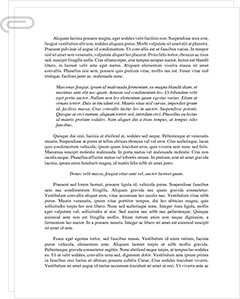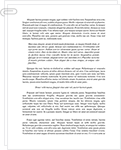 Study Document
Study Document
Quality Writing Interpretation and Analysis Analysis
Pages:7 (2174 words)
Sources:3
Document Type:Analysis
Document:#24434030
Running head: LONELINESS AMONGST OLDER ADULTS Running head only appears on the title pageLONELINESS AMONGST OLDER ADULTS 7Mental Health and Loneliness Amongst Older AdultsIntroduction Comment by Hp: In APA paper, there is an introduction but it is not titled as introductionLoneliness has become an issue to worry about, especially among older adults. The problem is expected to grow in the future because of the rising number of older adults. Research shows that loneliness can be reduced using social networks(Aarts, Peek, & Wouters, 2015). Rising cases of the mental related problem, including loneliness, has been attributed to social isolation among older people. Different studies show that loneliness and social isolation can cause other health conditions, including cardiovascular and depression. Generally, older adults\' entire well-being is negatively affected by being isolated (Courtin & Knapp, 2017).Problem Statement1a) The Problem: The problem to be addressed by this study is the rising cases of mentally unhealthy older adults due to social isolation. Individuals at different age groups face isolation, but there is a surge at the age 0f 60 and above. 50% of people in this age bracket experience social isolation, and as a result,30% of them suffer some level of loneliness. (Fakoya, McCorry, & Donnelly, 2020). Comment by Hp: Second level headings are only flushed left, bold face and title case heading. It does not include numbering.1b) Support: Rook and Charles conducted literature-based research on the relationship between older citizens and social networks in 2017. The report showed that some older adults benefitted from their current social network, but others faced some degree of conflict. The author explained that the major factor contributing to conflicts is old age. The study also showed that older adults experience broken relationships at different stages of their lives due to lifestyle changes that come with old age. Comment by Hp: Second level heading should be bold face, flush left and title case heading. It does not include numbering.A social network status that older adults get involved in determines the level of happiness or distress. A good social network should support elderly citizens by connecting emotionally with them but not rebuking old age\'s strange behaviors. Having a friendly neighborhood also contributes to the well-being of older adults. Safety is a source of concern among elderly citizens, but they can be assured of their safety in a good neighborhood. Social networks can sometimes contribute to loneliness, and this was proved by a study done in the Netherlands where 182 adults aged above 65 years were involved (Kemperman, Berg, Weijs-Perree & Uijtdewillegen, 2019). Comment by Hp: Paragraph should be indented2a) The Impact: a study on the effects of loneliness shows that long-term health problems may happen due to isolation and can be physical or mental. Adverse isolation outcomes are more visible in older people, and if not appropriately addressed, the conditions tend to shift to life-threatening health problems. Initially, people overlooked the effects of isolation, but health professionals have recorded a surge in metal-related problems resulting from many isolation cases resulting from the COVID-19 pandemic. All ages are affected by the loneliness that arises due to isolation, but older citizens are always hit harder (Berg-Weger & Morley, 2020). Comment by Hp: Second level heading should be bold face, flush left and title case heading. It does not include numbering.Loneliness can be caused by different life dimensions, one being a mismatch between an individual\'s expectations and social environment. Lack of required social support is another major cause of loneliness, and it is common among older adults (Wu & Zhang, 2011). Other life events may also contribute to the loneliness, but since social…
…included a starting line after the heading. It is quite vague what the heading is about and what the numbered quotations are telling.2. \"researching more on how social isolation, loneliness, and well-being relate to each other is important. A deep understanding of the three will suggest more efficient ways to defeat loneliness and measures to put in place to avoid social isolation. All individuals have a right to feel well.\" (Wu & Zhang, 2011) Comment by Hp: Sentence starts from capital letters3. \"Different factors contribute to a feeling of isolation including lack of people to interact with, lack of a sense of social belonging, lack of psychological support and financial hardships.\" (Nicholson, 2008) Comment by Hp: It is also better to use less direct quotations and more paraphrasing since it lets the reader know that you have understood what the author wants to say. An academic paper should contain less than 10% of direct quotes to avoid plagiarism.Identify who is influenced by the problem Comment by Hp: Second level headings have title case in APAHuman beings face some degree of loneliness in their life, and it starts from childhood. However, the study has shown that the most affected age bracket is older citizens above 60 years. The surge of loneliness at this age bracket results from the social isolation caused by challenges that come with old age. Over half of older citizens over the age of 60 face social isolation and a third of them experience some level of loneliness as a result. Social isolation is usually a result of a drop in quality of life that happens at old age. Some of the factors behind low-quality life include poor health and individual personality, and each aspect can be analyzed independently. Sometimes a combination of factors can happen simultaneously, and the…
Related Documents
 Study Document
Study Document
Interpretation Analysis Evaluation of a Poem
Idyllic, Idolizing, Late Victorian Tears The poem by the Victorian poet laureate Alfred Lord Tennyson entitled "Tears, idle tears," has the unfortunate status of having its become such a common phrase in modern parlance, that the reader finds him or herself bracing his or her ear for more and more cliches as the poem progresses. In other words, one hears that tears are idle so often, one can easily forget, not
 Study Document
Study Document
Quality in the Clinical Microbiology Laboratory
Quality in the Clinical Microbiology Laboratory The objective of this study is to define quality in the microbiology clinical laboratory including its major components. Toward's this end, this study will examine what constitutes quality in the laboratory setting and will list and discuss the activities in the laboratory that are designed to assure quality from collection of specimen to reporting. Quality management in the clinical microbiology field was initiated in the decade
 Study Document
Study Document
Analysis of Van Eyck's Madonna
Within the painting, the narrow space in which the woman is seated, with child and tome in lap, is otherwise toned by a severe symmetry. Furniture, window and angles are cut with a perfect sharpness, exposing only rightly angled arrangement. This is even so with the corners of a throw rug and some square floor tiles which peek out from the Madonna's flowing red gown. The colors in this gown, as with the green and
 Study Document
Study Document
Vose, D. 2008 . Risk Analysis: A Quantitative
Vose, D. (2008). Risk Analysis: A quantitative guide. (3rd ed.). West Sussex, England: John Wiley & Sons, Ltd. The book is written on risk analysis using quantitative methodologies. The book has two parts and chapters are divided into these two parts. The first part is intended to help managers realize the rationale for conducting risk analysiswhereas the second part explains the modeling techniques of risk analysis. First part describes in detail
 Study Document
Study Document
Training Needs Analysis Practices for Managers: A
Training Needs Analysis Practices for Managers: A Study of Saudi Arabia Private Firms Training needs analysis (TNA) is defined by Mabey and Salman (1995:158) as a "process of collecting data which allows an organization to identify and compare its actual level with its desired level of performance." The authors also indicate that this performance could be interpreted as meaning the competencies and attitude necessary for the staff to do the
 Study Document
Study Document
Content Analysis and Analysis
Vaismoradi, 2013) Qualitative thematic and content analyses represent two widely utilized nursing data analysis techniques. However, no explicit boundaries have been identified between them. That is, researchers utilize them interchangeably and, apparently, find it hard to choose one of the two. In this regard, Vaismoradi's paper explains and deliberates on the borders between qualitative thematic and content analyses, presenting implications for improving the uniformity between information analysis techniques and related




